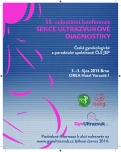Why do we still hesitate to accept the new international criteria for the diagnosis of gestational diabetes mellitus?
The current screening is non-uniform and does not correspondwith evidence-based medicine
Authors:
Hana Krejčí
; Kateřina Anderlová
Authors‘ workplace:
Gynekologicko-porodnická klinika 1. LF UK a VFN, Praha, přednosta prof. MUDr. A. Martan, DrSc.
Published in:
Ceska Gynekol 2014; 79(3): 206-212
Overview
Gestational diabetes mellitus (GDM) is the most common internal complication in pregnancy and similarly as the frequency of Type 2 diabetes rises in general population so does the frequency of GDM. The causes include unhealthy life style, growing incidence of overweight and obesity as well as older age of pregnant women. Older data reported the frequency of GDM in 3–4% of all pregnancies in the Czech Republic, whereas nowadays its frequency with using the same diagnostic criteria is more than two times higher. If we include the measurement of glycemia in 1 hour of oGTT, the frequency of GDM reaches more than 20%. In case we accept the new recommendation of the International Association for Diabetes in Pregnancy Study Groups (IADPSG), it is expected that the frequency of GDM will be even higher. IADPSG recommendation resulted from HAPO study (Hyperglycemia and Adverse Pregnancy Outcomes), a large international observational study on the relationship between mild hyperglycemia and pregnancy outcomes. Adoption of these new criteria is intensively discussed among experts all over the world. WHO adopted the IADPSG criteria in 2013. The Czech Diabetes Society committee adopted them in April 2014. Any official statement about the new criteria has not yet been issued by the Czech Gynecology and Obstetrics Society. This article analyzes the old and the new diagnostic criteria, summarizes the most common arguments in favor and against the IADPSG thresholds and tries to open the discussion about this important topic.
Keywords:
gestational diabetes mellitus, screening diabetesin pregnancy, diagnosing diabetes in pregnancy, oral glucose tolerance test, HAPO study, IADPSG
Sources
1. Agarwal, MM., Weigl, B., Hod, M. Gestational diabetes screening: The low-cost algorithm. Intern J Gynecol Obstet, 2011, 115S1, p. S30–S33.
2. Andělová, K. Doporučený postup provádění screeningu poruch glukózové tolerance v graviditě. Čes Gynek, 2009, 74, S1, s. 7.
3. Carpenter, MW., Coustan, DR. Criteria for screening tests for gestaional diabetes. Amer J Obstet Gynecol, 1982, 144, 7, p. 768–773.
4. Cheng, YW., Block-Kurbisch, I. Caughey, AB. Carpenter-Coustan criteria compared with the National Diabetes Date Group thresholds for gestational diabetes mellitus. Obstet Gynecol, 2009, 114, p. 326–332.
5. Crowther, CA., Hiller, JE., Moss, JR., et al. Effect of treatment of gestational diabetes mellitus on pregnancy outcomes. N Engl J Med, 2005, 352, p. 2477–2486.
6. Česká diabetologická společnost. Diabetes mellitus – laboratorní diagnostika a sledování stavu pacientů. DMEV, 2012, 1, s. 51–58.
7. Česká diabetologická společnost. Standardy péče o diabetes mellitus v těhotenství. DMEV, 2007, 4, s. 229–231.
8. Franeková, J., Jabor, A. Gestační diabetes mellitus: analýza 2043 výsledků oGTT – je čas na změnu? Klin Biochem Metab, 2010, 18, 39, s. 30–37.
9. Hillier, TA., Pedula, KL., Schmidt, MM. Childhood obesity and metabolic imprinting. Diabetes Care, 2007, 30, 9, p. 2287–2292.
10. International Association of Diabetes and Pregnancy Study Groups Recommendations on the Diagnosis and Classification of Hyperglycemia in Pregnancy. Diabetes Care, 2010, 33, 3, p. 676–682.
11. Landon, MB., Spong, CY., Thom, E., et al. A multicenter randomized trial of treatment for mild gestational diabetes. N Engl J Med, 2009, 361, p. 1339–1348.
12. Long, H. Diagnosing gestational diabetes: can expert opinions replace scientific evidence? Diabetologia, 2011, 54, p. 2211–2213.
13. Mission, JF., Ohno, MS., Cheng, YV., Caughey, AB. Gestational diabtess screening with new IADPSG guidelines: a cost-effectiveness analysis. Am J Obstet Gynecol, 2012, 207, 326e, p. 1–9.
14. Moses, RG. Gestational diabetes mellitus: Implications of an increased frequency with IADPSG criteria. Diabetes Care, 2012, 35, p. 461–462.
15. Negrato, CA., Gomes, MB. Historical facts of screening and diagnosing diabetes in pregnancy. Diabet Metabol Syndrome, 2013, 5, 22, p. 1–8.
16. O‘Sullivan, JB., Mahan, CM. Criteria for oral glucose tolerace test in pregnancy. Diabetes, 1964, 13, p. 278–285.
17. Ryan, EA. Diagnosing gestational diabetes. Diabetologia, 2011, 54, s. 480–486.
18. Sacs, DA., Hadden, DR., Maresh, M. Frequency of Gestational Diabetes Mellitus at Collaborating Centers Based on IADPSG Consensus Panel-Recommended Criteria. Diabetes Care, 2012, 35, p. 526–528.
19. The HAPO Study Cooperative Research Group. Hyperglycemie and adverse pregnancy outcomes. N Engl J Med, 2008, 358, p. 1991–2002.
20. Visser, GHA., de Valk, HW. Is the evidence strong enough to change the diagnostic criteria for gestational diabetes now? Am J Obstet Gynecol, 2013, 208, 4, p. 260–264.
21. Werner, EF., Pettker, CM., Zuckerwise, L., et al. Screening for gestational diabetes mellitus: Are the criteria proposed by the International Association of the Diabetes and Pregnancy Study Groups cost-effective? Diabetes Care, 2012, 35, p. 529–535.
22. WHO. Diabetes Mellitus: Report of WHO Study Group, World Health Organization, Geneva, Switzerland, 1985.
23. WHO. Diagnostic Criteria and Classification of Hyperglycaemia First Detected in Pregnancy, 2013, http://apps.who.int/iris/bitstream/10665/85975/1/WHO_NMH_MND_13.2_eng.pdf
Labels
Paediatric gynaecology Gynaecology and obstetrics Reproduction medicineArticle was published in
Czech Gynaecology

2014 Issue 3
Most read in this issue
- Diagnostic algorithm in pregnancies of uncertain viability or unknown location – a review of the latest recommendations
- Myo-inositol in the treatment of polycystic ovary syndrome
-
Prenatal diagnosis of skeletal dysplasia in first trimester of pregnancy
X-linked dominant chondrodysplasia punctata - HELLP syndrome complicated by liver rupture – case report
